Fabulous Philippines > Mactan Shrine (Lapu Lapu Shrine; Magellan Shrine), Mactan Island, Cebu, Philippines
Mactan Shrine (including the Lapu Lapu Shrine and the Magellan Shrine)
Mactan Island, Cebu
|
Share this page:
Mactan Shrine The Mactan Shrine, located on Mactan Island, just of the coast from Cebu City, is a must-see for everyone interested in Filipino history. It commemorates the Battle of Mactan that took place in 1521 between the Spanish and the Visayan (central Philippines) native people in April 1521 and, along with paintings and plaques about that battle, it also contains two other important shrines -- the Lapu Lapu Shrine and the Magellan Shrine 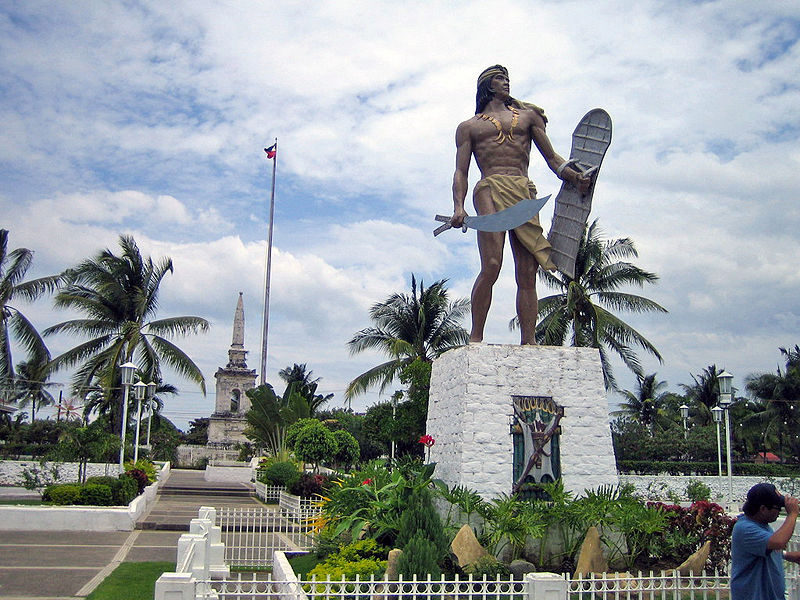 View of the Mactan Shrine, showing (in the foreground) the Lapu Lapu Shrine and (in the background) the Magellan Shrine. Lapu Lapu Shrine 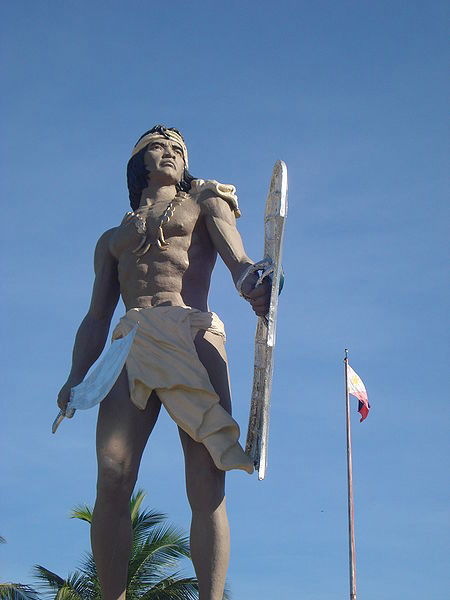 The Lapu Lapu Shrine, Mactan Island The Lapu Lapu shrine is a 20 meter (65.5 feet) high, bronze statue of Lapu Lapu (circa 1491-1547 AD), the Filipino warrior king who commanded the native forces that fought the invading Spanish forces in the Battle of Mactan in 1521 and killed their leader, the navigator Ferdinand Magellan. The Lapu Lapu statue is said to be on the exact spot where the battle was fought and where Magellan was killed. The statue shows Lapu Lapu holding a sword in one hand and a shield on the other (these two weapons are said to have been used by Lapu Lapu in his combat with Magellan). Lapu Lapu was one of two chieftains and kings (datu) of Mactan Island, and he vigorously resisted the early Spanish colonists in their attempts to conquer the Philippines and convert them to Christianity. When Ferdinand Magellan arrived in the Philippines in 1521, he took possession of the Philippines in the name of Spain. After early friendly encounters with the rajahs of the islands of Homonhon and Cebu in the central Philippines, Magellan and his men faced off against Lapu Lapu and his warriors in the Battle of Mactan (Kadaugan sa Mactan). During this battle the Spanish burned a village of the inhabitants of Mactan. Magellan was then killed by Lapu Lapu. History records that Lapu Lapu was the first Philippine native to resist foreign invasion and colonization. As such, he is regarded as the first national hero of the Philippines. In addition to the above-mentioned statue (also known as the Lapu Lapu Monument), a church has been erected in his honor and the town of Opon, Mactan Island, was renamed Lapu-Lapu City. The Battle for Mactan is re-enacted most years on the beach at Magellan Bay, Mactan Island. Magellan Monument Also inside the Mactan Shrine and just meters away from the Lapu Lapu Shrine is the Magellan Shrine. 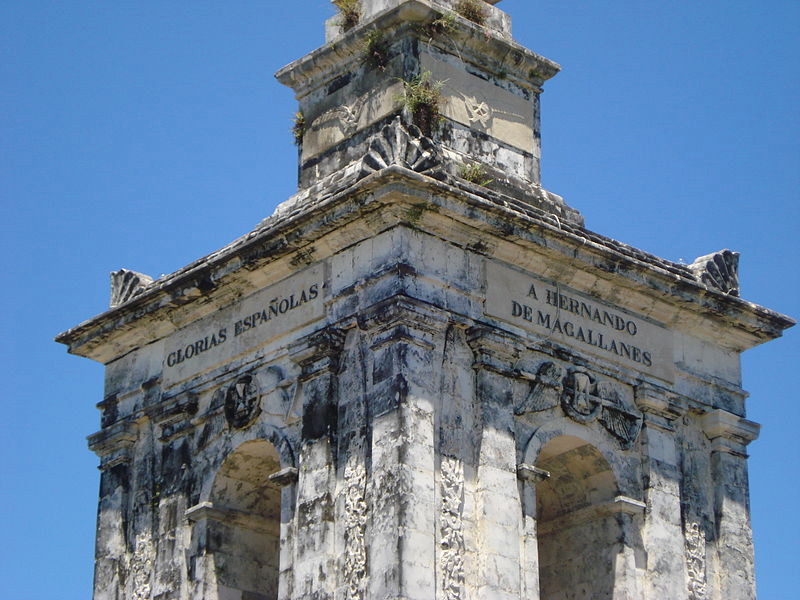 Two sides of the Magellan Shrine (showing Magellan's name) This monument was raised to Ferdinand Magellan, the Portuguese navigator who commanded the Spanish fleet sent out by the Spanish king Charles I (later the Holy Roman Emperor Charles V) in 1519 to find a western sea route to Asia (via the southern tip of South America) and the spices, such as nutmeg and cloves, that the "Spice Islands" (now known as the Moluccas and part of Indonesia) produced. Europe needed those spices to preserve and spice foods in that pre-refrigeration era. This is why the route is often called the "spice route". A western route to Asia (via South America) had to be found by Spain as its rival, Portugal, already dominated the eastern route to Asia (via the Cape of Good Hope at the southern tip of Africa). 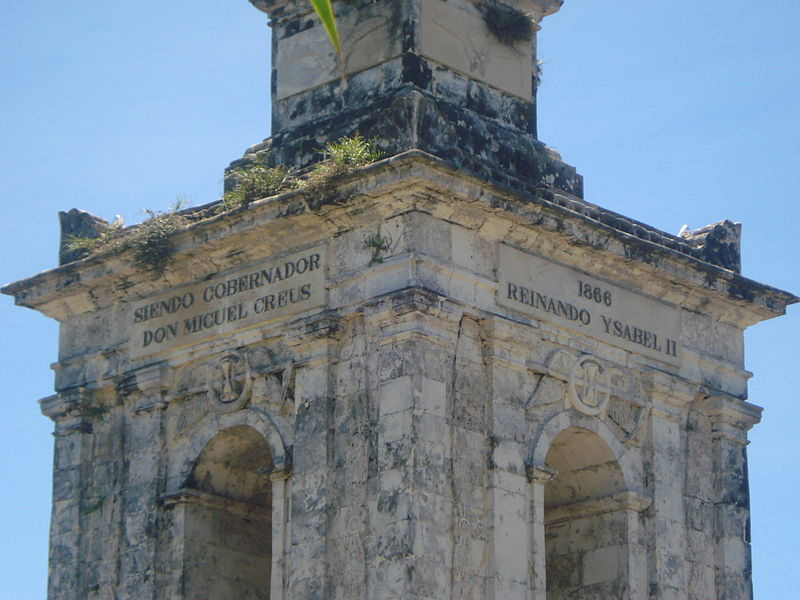 The other two sides of the Magellan Shrine (showing the names of the Spanish governor of the Philippines and the Spanish Queen) The Magellan Monument was built in 1866 by the Spanish colonial rulers of the Philippines. On one side Magellan's name is written in the original Portuguese language. On a second side is a dedication to "Spanish glory". On a third side is the name of the Spanish governor of the Philippines of the time (Don Miguel Creuz) and on the fourth side is the name of the Spanish monarch of the time (Queen Ysabel II). Although Magellan is now regarded by many Filipino historians as the "enemy" who was killed by the national hero, Lapu Lapu, Magellan is still remembered as the person who brought Christianity to the Philippines (commemorated by Magellan's Cross Memorial in Cebu City) and as the commander of the fleet which achieved the first ever circumnavigation of the earth. The Magellan Marker 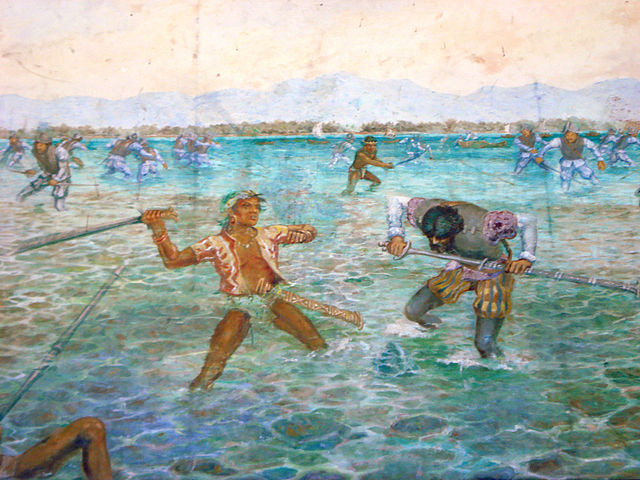 Detail from a panoramic painting of the Battle of Mactan In an open-fronted shelter inside the grounds of the Mactan Shrine is a panoramic painting of the Battle of Mactan and the so-called Magellan Marker erected in 1941 by the National Historical Institute. It constructed of marble and has two plaques. On the plaque on the front of the marker is the following text: Lapulapu Here on 27 April 1521, Lapulapu and his men repulsed the Spanish invaders, killing their leader Ferdinand Magellan thus Lapu Lapu became the first Filipino to have repelled European aggression. On the back of the marker is the other plaque with the following text: Ferdinand Magellan's Death On this spot Ferdinand Magellan died on April 27, 1521 wounded in an encounter with the soldiers of Lapu Lapu, Chief of Mactan Islands. One of Magellan's ships, The Victoria, under the command of Juan Sebastian Elcano, sailed from Cebu on May 1, 1521 and anchored at San Lucar de Barrameda on September 6, 1522 thus completing the first circumnavigation of the earth. Near the Mactan Shrine In the close vicinity of the Mactan Shrine you can still see the mangroves and shallow water that were to be the downfall of Magellan in 1521 who was not able to bring his big guns close enough to the shore to use them against the forces of Lapu Lapu. Share this page:
(David Paul Wagner on Google+) |